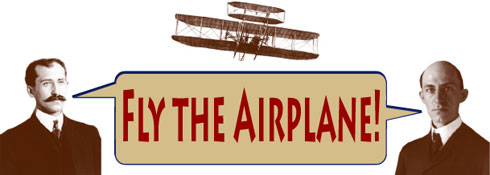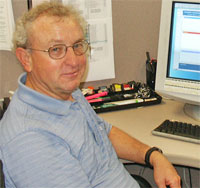
In
all phases of flight, the first and foremost responsibility
of the pilot, in any type of aircraft, is to fly
the airplane. When there is a distraction or a temptation
to fixate on an abnormal situation or an emergency, flying
the airplane has to be the first consideration.
In
each of the following ASRS reports, the enduring wisdom of
the admonishment, fly the airplane,
was reinforced.
Fly
the airplane, everything else is secondary.
Airline
Loops
Flying
the airplane can be thought of as making the aircraft do
what you want it to do. Whether that is accomplished by
direct manipulation of the controls or through data input
to an electronic system that manipulates the controls, the
pilot is still responsible for ensuring that the airplane
goes where he or she intends.
These
three ASRS reports point out what can happen when pilots
get out of the loop and relinquish command responsibility
to the autoflight system.
-
We
were given a clearance to cross 50 miles southwest of
the VOR at FL200.... After double checking that I had
properly placed the crossing restriction in the FMC
(Flight Management Computer), the system displayed an
immediate descent prompt.... I selected this option
and observed on the flight mode annunciator that a descent
was indicated and an altitude (20,000) was armed for
capture.... I focused my attention on the FMC to adjust
the descent rate and to observe the distance to the
bottom of the descent point. The Captain then said,
"What's going on?" I observed that the aircraft
had entered a subtle climb, seemingly on its own accord.
While arresting the climb, our altitude peaked at 400
feet above our assigned cruise altitude....The automation
took me, the pilot flying, out of the loop as I relied
on the aircraft to execute the descent without monitoring
the aircraft's initial entry into the descent....
We
have to remember that no matter how much automation there
is, the basics still apply. Fly
the aircraft from the moment it leaves the
gate until it is parked once again at the gate. Don't
become passive and let the aircraft fly you. The more
automation there is in the aircraft, the more the flight
crew should work to remain an active and integral part
of the loop.
-
I
was the pilot flying. We were inbound at FL330. We were
given clearance to cross 65 miles northwest of INTXN at
FL230. I set 23,000 feet in the altitude window. The Captain
worked the FMC. We were direct INTXN with several abeam
fixes preceding INTXN on the FMC Legs page. The aircraft
was in VNAV (Vertical Navigation) path. The Captain created
the INTXN/-65/230 fix and shortly thereafter, the aircraft
started a descent. When Center called to confirm our clearance,
we were passing FL260 approaching the 65 mile fix. We
were well above our crossing restriction....
One
of the factors in this error was automation complacency.
The FMC does such a great job of flying the aircraft
that normally you “set it and forget it.”
I usually check and double check the automation.
And, in this case, manually compute the descent
rate, speeds, progress, etc., to ensure meeting
the crossing restriction. But today, distractions
and fatigue led to poor prioritizing and getting
out of the loop. The lesson is to reemphasize the
critical need to set correct priorities, to overcome
the distractions, and always
fly the aircraft.
-
While
flying [an] arrival.... [procedure], we were issued holding
instructions. The holding data was entered in the FMC
and the airplane was slowed prior to arriving at the holding
fix. As we entered the holding pattern, I was about to
report to ATC when we received a call from the flight
attendant. Although this call turned out to be routine,
it came across as an emergency call from the cabin....
At this point, the Captain called my attention to a vibration
on the airplane. After a brief moment of investigation,
we discovered that the source of the vibration was a loss
of airspeed, which, when combined with the bank angle
of the aircraft, resulted in a stall and a subsequent
loss of altitude (approximately 500 feet). We tried to
get a lower altitude from ATC, but they were unable to
accommodate the request due to other traffic holding below
us. Once recovery was complete, we returned immediately
to our assigned altitude. The distraction, although momentary,
diverted attention from the task at hand. In hindsight
it would have been prudent to emphasize to the Captain
the need for him to
fly the airplane,
before I got out of the loop with a call that we thought
was of an emergency nature. I'm not positive this would
have prevented our situation, but it may have been a good
reminder of the priority of our tasks.
From
the Captain's report on the same incident:
-
We
were busy as we entered the holding pattern, so I decided
to enter a "ballpark"” holding speed versus
looking one up. The ballpark speed (Vref +20) works in
most situations, but not this one.
Lesson learned — fly
the airplane
Forgetting
to fly the airplane is
not a problem restricted to air carrier pilots using sophisticated
autoflight systems. In the following reports, unexpected events
distracted pilots from flying a BE35, a Mooney, and a C172
respectively.
-
I
was on an IFR flight....when the cabin door opened about
two inches, the passenger shoulder harness flew out, and
the buckle began banging against the rear window. I attempted
to retrieve the harness and close the door. When I turned
back to the controls, the airplane was in an unusual attitude
and 2,000 feet below the assigned altitude. I recovered
and proceeded to [destination] uneventfully. I learned
a number of lessons, but most importantly,
fly the airplane first!
-
I departed on an IFR flight plan and was cleared on course
to 6,000 feet (final altitude). I leveled at 6,000 feet,
and completed the post climb/cruise checklist when the
Master Caution illuminated. The caution panel indicated
a low voltage alarm then the alarm cleared and the ammeter
was normal. Approximately three minutes later, the symptoms
reappeared and remained. I was in visual conditions. I
contacted ATC and advised that I needed to return to the
airport immediately. I decided to declare an emergency.
ATC responded with a clearance from present position direct.
I turned the heading bug to the new heading....and began
the emergency checklist. At some point, I inadvertently
disengaged altitude hold and allowed the aircraft to descend
to 5,000 feet. I didn't notice it until approach control
inquired about my altitude, then cleared me to maintain
5,000 feet. I was cleared for the VOR approach which was
uneventful.
Basically,
the reason for this report is that I failed to do
what I drill into my students — fly
the airplane... first, last, and always.
I was engrossed in the checklist and didn't notice
altitude hold was no longer engaged until ATC questioned
me. I devoted undue attention to a (relatively)
minor problem to the exclusion of commanding the
flight.
-
We
were on the Localizer 15 approach....with an 800 foot ceiling.
Approach control cleared us for the approach, but did
not hand us off to the tower. I became distracted trying
to raise approach on the radio and then trying to call
the tower directly. I focused on the radio and forgot
to monitor my altitude. My safety pilot finally pointed
out that I was at 400 feet (about 150 feet below the MDA)
and descending rapidly. Fortunately, we had broken out
of the clouds and had the field in sight, so I immediately
climbed to a safe altitude and completed the approach
and landing. If there hadn't been a second pilot aboard
to monitor the approach, I might have flown a perfectly
good airplane right into the ground. I forgot a fundamental
rule of instrument flying: first you aviate (you fly
the airplane), then you navigate. Only then
do you try to communicate. I allowed myself to get distracted
over something that was not important. I should have either
continued the approach, treating it as a "lost comm."
situation, or better yet, asked the second pilot to try
to straighten out the handoff with approach. Not only
did I become distracted, but I also failed to use all
the resources at my disposal. I hope I learned a lesson
today because I'm lucky to be alive!
Corporate
Climb
Confronted
with multiple system failure messages, this G5 crew forgot
lesson one, fly the airplane.
-
I
was the First Officer, pilot not flying, on an IFR repositioning
flight. We were talking with....Center and....as we passed
through FL180 and changed our altimeters to 29.92, we
began getting failure messages on our message screen.
The first message was ADC #1 Fail followed by numerous
other messages which were appearing and then clearing.
While trying to interpret what was happening and determine
what data was accurate, we climbed through our assigned
FL190. [Center] called us and asked our altitude. We reported
FL228 where we had arrested the climb. We advised them
of our problem and asked for an immediate return to ZZZ....We
were still unsure of the reliability of our instruments
and compared them with our standby instruments until landing
to ensure accuracy. We also made approach control aware
of our situation and had them monitor our ground path
and altitude readouts. Failure messages were appearing
and going away so rapidly during the episode that we were
unable to determine what the main problem was. We had
as many as ten failure messages at a time appearing. Failure
to level at FL190 was caused by failure of the autoflight
system complicated by the multiple other failures.
Lesson
learned —
fly the airplane first.
Military
Attention
A C-141
flight crew recommends that pilots should prioritize their
tasks, but always put one item at the top of the list....fly
the airplane.
-
Situation:
We were flying a C-141 on a one-time ferry flight with....numerous
maintenance discrepancies....We had the terrain warning
system circuit breaker pulled for erroneous and continuous
"Pull up" warnings. Since this circuit breaker
was pulled, most of our aural warnings in the aircraft
were inoperative, including the altitude "beeps"
of 1,000 feet and 300 feet below or above the pre-selected
altitude. While we were passing 10,000 feet, in the climb
to 12,000 feet, we were trying to restore the #1 Display
unit, as well as the Moving Map display on the pilot's
side, when we received a "Traffic" aural advisory
from our TCASII. Our attention was diverted to the Multi-Function
Display unit which displays the traffic symbols. We decreased
the range on the unit, in order to better see exactly
where the traffic was in relation to our aircraft. Then
we noticed we had climbed through our assigned altitude
of 12,000 feet and were near 13,000 before we started
back down. Center called out traffic at our 10 o'clock
position, while we were in the descent....
Recommendation: Remember that
flying the airplane
is the first priority
no matter what else is happening.
Meet
the Staff
Dave
Austin

Captain
Dave "Sherlock" Austin joined the staff
of the Aviation Safety Reporting System in 2004 as
an Aviation Safety Analyst. After serving as a Naval
Aviator, Dave was an air carrier pilot for 28 years.
Captain Austin has accumulated more than 15,000 flight
hours in a wide variety of aircraft including the
A-330, B-767, B-757, B-737, MD-80, DC-9, P-3, and
P2V.
From
1995 to 2000 Dave completed a Master's Thesis (with
research at NASA Ames Research Center) on a formal
methodology for examining
human actions in an active complex machine system.He
also provided operational airline experience and consulted
on various NASA projects before joining the ASRS team
|


